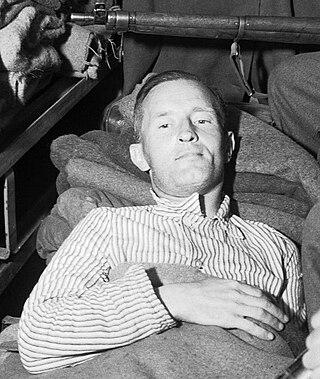
The BBC World Service is an international broadcaster owned and operated by the BBC. It is the world's largest external broadcaster in terms of reception area, language selection and audience reach. It broadcasts radio news, speech and discussions in more than 40 languages to many parts of the world on analogue and digital shortwave platforms, internet streaming, podcasting, satellite, DAB, FM and MW relays. In 2024, the World Service reached an average of 450 million people a week. In November 2016, the BBC announced that it would start broadcasting in additional languages including Amharic and Igbo, in its biggest expansion since the 1940s.

Shortwave radio is radio transmission using radio frequencies in the shortwave bands (SW). There is no official definition of the band range, but it always includes all of the high frequency band (HF), which extends from 3 to 30 MHz ; above the medium frequency band (MF), to the bottom of the VHF band.
International broadcasting consists of radio and television transmissions that purposefully cross international boundaries, often with then intent of allowing expatriates to remain in touch with their countries of origin as well as educate, inform, and influence residents of foreign countries. Content can range from overt propaganda and counterpropaganda to cultural content to news reports that reflect the point of view and concerns of the originating country or that seek to provide alternative information to that otherwise available as well as promote tourism and trade. In the first half of the twentieth century, international broadcasting was used by colonial empires as a means of connecting colonies with the metropole. When operated by governments or entities close to a government, international broadcasting can be a form of soft power. Less frequently, international broadcasting has been undertaken for commercial purposes by private broadcasters.

Black propaganda is a form of propaganda intended to create the impression that it was created by those it is supposed to discredit. Black propaganda contrasts with gray propaganda, which does not identify its source, as well as white propaganda, which does not disguise its origins at all. It is typically used to vilify or embarrass the enemy through misrepresentation.

Gustav Siegfried Eins (GS1) was a British black propaganda radio station during World War II operated by the Political Warfare Executive (PWE). It was the brainchild of Sefton Delmer, a former BBC German service announcer recruited by PWE in 1940, and claimed to be an illegal radio station operating within Nazi Germany. The callsign was based on the German Army phonetic alphabet for the letters GS, but had no meaning.

Soldatensender Calais (G.9) was a British black propaganda broadcaster during the Second World War operated by the Political Warfare Executive. It pretended to be a station of the German military broadcasting network. The station was in operation between 14 November 1943 and 30 April 1945, when it ceased operations.

During World War II, the Political Warfare Executive (PWE) was a British clandestine body created to produce and disseminate both white and black propaganda, with the aim of damaging enemy morale and sustaining the morale of countries occupied or allied with Nazi Germany.

Denis Sefton Delmer was a British journalist of Australian heritage and propagandist for the British government during the Second World War.

Shortwave listening, or SWLing, is the hobby of listening to shortwave radio broadcasts located on frequencies between 1700 kHz and 30 MHz (30 000 kHz). Listeners range from casual users seeking international news and entertainment programming, to hobbyists immersed in the technical aspects of long-distance radio reception and sending and collecting official confirmations that document their reception of remote broadcasts (DXing). In some developing countries, shortwave listening enables remote communities to obtain regional programming traditionally provided by local medium wave AM broadcasters. In 2002, the number of households that were capable of shortwave listening was estimated to be in the hundreds of millions.
Azad Hind Radio was a radio service that was started under the leadership of Subhas Chandra Bose in 1942 to encourage Indians to fight against the British. Though initially based in Nazi Germany, its headquarters were shifted to Japanese occupied Singapore following the course of the war in Southeast Asia. After Netaji's departure to Southeast Asia, the German operations were continued by A. C. N. Nambiar, the head of the Indian Legion in Nazi Germany and later ambassador of the Arzi Hukumate Azad Hind in Germany.

British Security Co-ordination (BSC) was a covert organisation set up in New York City by the British Secret Intelligence Service (MI6) in May 1940 upon the authorisation of the Prime Minister, Winston Churchill.

The Psychological Warfare Division of Supreme Headquarters Allied Expeditionary Force was a joint Anglo-American organization set-up in World War II tasked with conducting (predominantly) white tactical psychological warfare against German troops and recently liberated countries in Northwest Europe, during and after D-Day. It was headed by US Brigadier-General Robert A. McClure. The Division was formed from staff of the US Office of War Information (OWI) and Office of Strategic Services (OSS) and the British Political Warfare Executive (PWE).
WNYW was a shortwave radio station that broadcast from Scituate, Massachusetts, in the United States. During WWII the station became important for the British and the Norwegian information services. On October 20, 1973, Family Stations, Inc., acquired the station to be part of its Family Radio network and changed the call letters to WYFR. Family Stations eventually progressively moved the transmitters to their current site in Okeechobee, Florida. The transmitter site in Scituate continued to operate until November 16, 1979, when it was switched off for the last time.

Aspidistra was a British medium-wave radio transmitter used for black propaganda and military deception purposes against Nazi Germany during World War II. At times in its history it was the most powerful broadcast transmitter in the world. Its name – after the popular foliage houseplant – was inspired by the 1938 comic song "The Biggest Aspidistra in the World", best known as sung by Gracie Fields.

World War II Radio Heroes: Letters of Compassion is a book by psychologist Lisa Spahr, co-authored with Austin Camacho, that recounts her personal investigation of the activities of shortwave radio listeners who notified families of captured U.S. military personnel of their status as prisoners of war during World War II. It documents Spahr's search to locate and thank the listeners who wrote letters to her great-grandmother reporting details of her grandfather's capture and internment in a German prison camp in 1943.
Radio propaganda is propaganda aimed at influencing attitudes towards a certain cause or position, delivered through radio broadcast. The power of radio propaganda came from its revolutionary nature. The radio, like later technological advances in the media, allowed information to be transmitted quickly and uniformly to vast populations. Internationally, the radio was an early and powerful recruiting tool for propaganda campaigns.

Lord Haw-Haw was a nickname applied to William Joyce and several other people who broadcast Nazi propaganda to the United Kingdom from Germany during the Second World War. The broadcasts opened with "Germany calling, Germany calling," spoken in an affected upper-class English accent. The same nickname was also applied to some other broadcasters of English-language propaganda from Germany, but it is Joyce with whom the name is overwhelmingly identified.
XGRS was a Shanghai-based radio station broadcasting on both shortwave and long wave which was owned and operated by the German government in Japanese-occupied China during World War II. Originally established as a German-language station designed to provide news and information to German residents of China, in 1940 it began broadcasting a multilingual program schedule with alternating broadcasts in English, German, Chinese, Russian, Japanese, and Hindi. It operated from the Kaiser Wilhelm School.
This is a list of events from British radio in 1940.
The Londoner Rundfunk of the BBC was a German language radio service running from 1938 until 1999 as part of the wider BBC European Service. It began operating during the Second World War and continued running until after the dissolution of the GDR and the end of the Cold War. With a broadcast time that never exceeded a few hours a day what was first conceived as a propaganda broadcast became a source for reliable information on the state of the war, and later the 'voice of the free world' to those behind the Iron Curtain.














